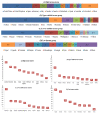Disparities in Cardiovascular Research Output and Disease Outcomes among High-, Middle- and Low-Income Countries - An Analysis of Global Cardiovascular Publications over the Last Decade (2008-2017)
- PMID: 33598384
- PMCID: PMC7845477
- DOI: 10.5334/gh.815
Disparities in Cardiovascular Research Output and Disease Outcomes among High-, Middle- and Low-Income Countries - An Analysis of Global Cardiovascular Publications over the Last Decade (2008-2017)
Abstract
Background: Cardiovascular disease (CVD) is the leading cause of death and disability worldwide. Health research is crucial to managing disease burden. Previous work has highlighted marked discrepancies in research output and disease burden between high-income countries (HICs) and low- and lower-middle-income countries (LI-LMICs) and there is little data to understand whether this gap has bridged in recent years. We conducted a global, country level bibliometric analysis of CVD publications with respect to trends in disease burden and county development indicators.
Methods: A search filter with a precision and recall of 0.92 and 0.91 respectively was developed to extract cardiovascular publications from the Web of Science (WOS) for the years 2008-2017. Data for disease burden and country development indicators were extracted from the Global Burden of Disease and the World Bank database respectively.
Results: Our search revealed 847,708 CVD publications for the period 2008-17, with a 43.4% increase over the decade. HICs contributed 81.1% of the global CVD research output and accounted for 8.1% and 8.5% of global CVD DALY losses deaths respectively. LI-LMICs contributed 2.8% of the total output and accounted for 59.5% and 57.1% global CVD DALY losses and death rates.
Conclusions: A glaring disparity in research output and disease burden persists. While LI-LMICs contribute to the majority of DALYs and mortality from CVD globally, their contribution to research output remains the lowest. These data call on national health budgets and international funding support to allocate funds to strengthen research capacity and translational research to impact CVD burden in LI-LMICs.
Keywords: Bibliometrics; Cardiovascular disease burden; Low middle income countries; global cardiovascular health; low income countries.
Copyright: © 2021 The Author(s).
Conflict of interest statement
The authors have no competing interests to declare.
Figures









Similar articles
-
Global cardiovascular research output, citations, and collaborations: a time-trend, bibliometric analysis (1999-2008).PLoS One. 2013 Dec 31;8(12):e83440. doi: 10.1371/journal.pone.0083440. eCollection 2013. PLoS One. 2013. PMID: 24391769 Free PMC article.
-
Global, Regional, and National Death, and Disability-Adjusted Life-Years (DALYs) for Cardiovascular Disease in 2017 and Trends and Risk Analysis From 1990 to 2017 Using the Global Burden of Disease Study and Implications for Prevention.Front Public Health. 2021 Oct 29;9:559751. doi: 10.3389/fpubh.2021.559751. eCollection 2021. Front Public Health. 2021. PMID: 34778156 Free PMC article.
-
Temporal trends in inequalities of the burden of cardiovascular disease across 186 countries and territories.Int J Equity Health. 2023 Aug 24;22(1):164. doi: 10.1186/s12939-023-01988-2. Int J Equity Health. 2023. PMID: 37620895 Free PMC article.
-
The economic burden of cardiovascular disease and hypertension in low- and middle-income countries: a systematic review.BMC Public Health. 2018 Aug 6;18(1):975. doi: 10.1186/s12889-018-5806-x. BMC Public Health. 2018. PMID: 30081871 Free PMC article.
-
Endemic Cardiovascular Diseases of the Poorest Billion.Circulation. 2016 Jun 14;133(24):2561-75. doi: 10.1161/CIRCULATIONAHA.116.008731. Circulation. 2016. PMID: 27297348 Review.
Cited by
-
Development and Evaluation of the International Council of Cardiovascular Prevention and Rehabilitation (ICCPR) Program Certification for Low-Resource Settings.Int J Gen Med. 2023 Nov 9;16:5199-5214. doi: 10.2147/IJGM.S423209. eCollection 2023. Int J Gen Med. 2023. PMID: 38021048 Free PMC article.
-
Disparities in Representation of Asian Participants and Investigators in Cardiometabolic Trials.JACC Asia. 2023 Aug 8;3(5):736-738. doi: 10.1016/j.jacasi.2023.06.006. eCollection 2023 Oct. JACC Asia. 2023. PMID: 38094994 Free PMC article.
-
Global pattern of cardiovascular disease management in patients with cancer and impact of COVID-19 on drug selection: IRAQ-IC-OS survey-based study.Front Cardiovasc Med. 2022 Sep 21;9:979631. doi: 10.3389/fcvm.2022.979631. eCollection 2022. Front Cardiovasc Med. 2022. PMID: 36211547 Free PMC article.
-
[Bibliometric analysis of peruvian scientific production in cardiology and cardiovascular medicine].Arch Peru Cardiol Cir Cardiovasc. 2021 Sep 30;2(3):167-174. doi: 10.47487/apcyccv.v2i3.157. eCollection 2021 Jul-Sep. Arch Peru Cardiol Cir Cardiovasc. 2021. PMID: 37727515 Free PMC article. Spanish.
-
Artificial intelligence in the risk prediction models of cardiovascular disease and development of an independent validation screening tool: a systematic review.BMC Med. 2024 Feb 5;22(1):56. doi: 10.1186/s12916-024-03273-7. BMC Med. 2024. PMID: 38317226 Free PMC article.
References
-
- World Health Organization. Global status report on noncommunicable diseases 2014 World Health Organization, 2014.
-
- World Health Organization. Noncommunicable diseases country profiles 2014. 2014.
-
- Vos T, Abajobir AA, Abate KH, Abbafati C, Abbas KM, Abd-Allah F, et al. Global, regional, and national incidence, prevalence, and years lived with disability for 328 diseases and injuries for 195 countries, 1990–2016: A systematic analysis for the Global Burden of Disease Study 2016. The Lancet. 2017; 390(10100): 1211–59. DOI: 10.1016/S0140-6736(17)32154-2 - DOI - PMC - PubMed
Publication types
MeSH terms
Grants and funding
LinkOut - more resources
Full Text Sources
Other Literature Sources
Medical
Miscellaneous

